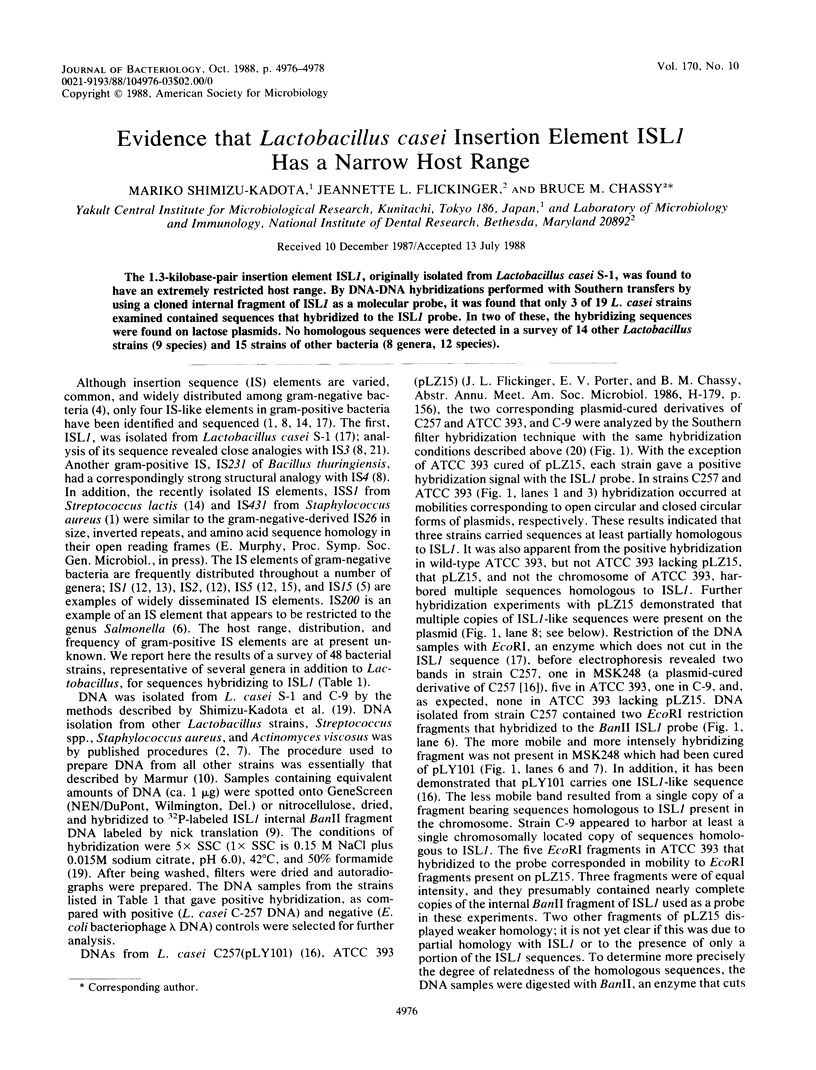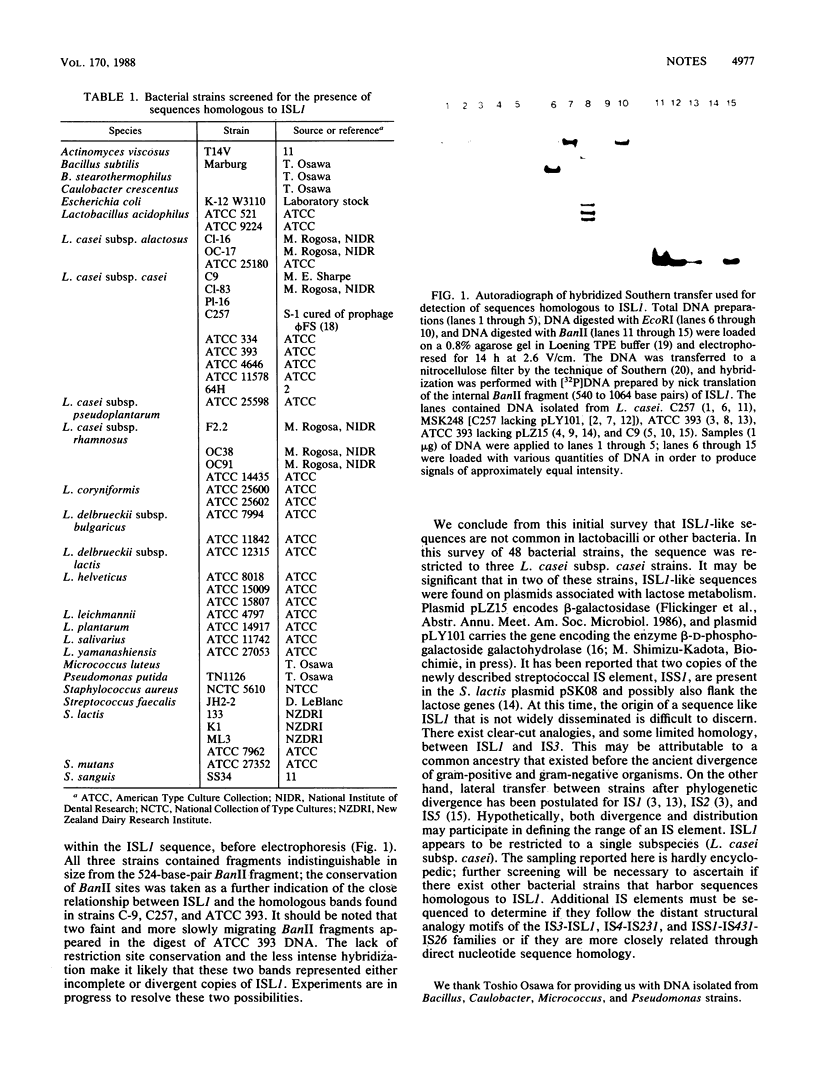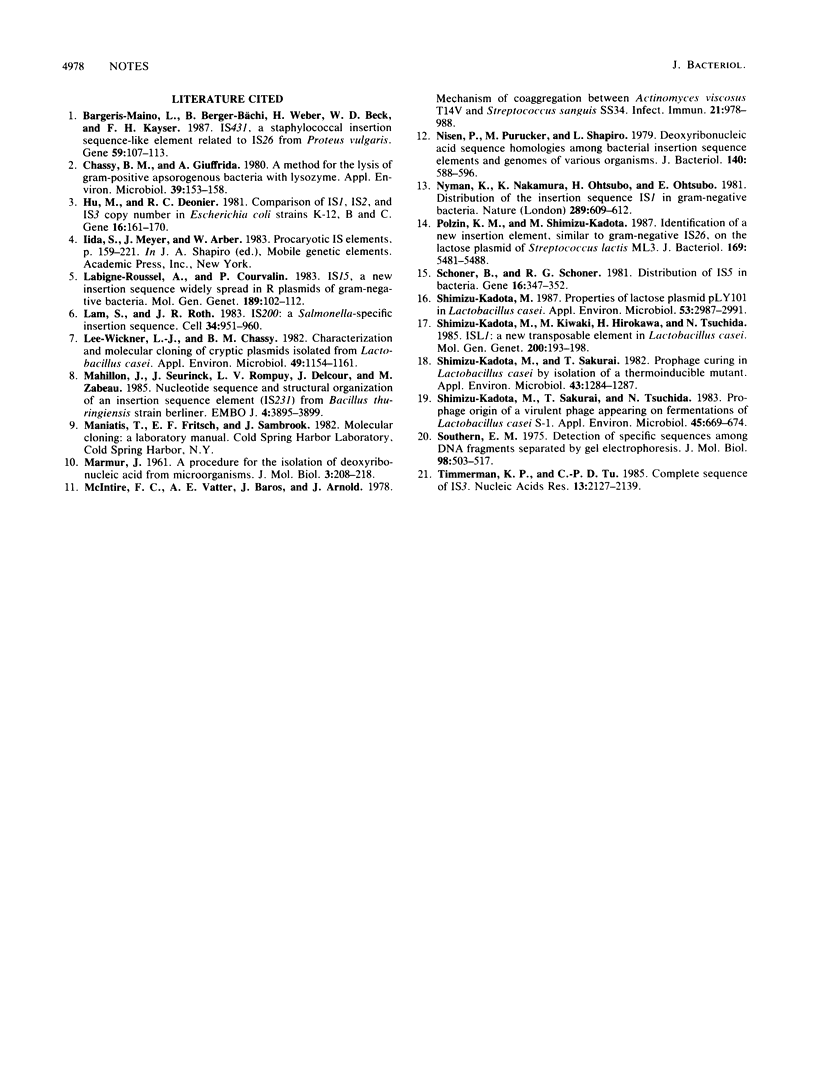Abstract
The 1.3-kilobase-pair insertion element ISL1, originally isolated from Lactobacillus casei S-1, was found to have an extremely restricted host range. By DNA-DNA hybrizations performed with Southern transfers by using a cloned internal fragment of ISL1 as a molecular probe, it was found that only 3 of 19 L. casei strains examined contained sequences that hybridized to the ISL1 probe. In two of these, the hybridizing sequences were found on lactose plasmids. No homologous sequences were detected in a survey of 14 other Lactobacillus strains (9 species) and 15 strains of other bacteria (8 genera, 12 species).
Full text
PDF


Images in this article
Selected References
These references are in PubMed. This may not be the complete list of references from this article.
- Barberis-Maino L., Berger-Bächi B., Weber H., Beck W. D., Kayser F. H. IS431, a staphylococcal insertion sequence-like element related to IS26 from Proteus vulgaris. Gene. 1987;59(1):107–113. doi: 10.1016/0378-1119(87)90271-x. [DOI] [PubMed] [Google Scholar]
- Chassy B. M., Giuffrida A. Method for the lysis of Gram-positive, asporogenous bacteria with lysozyme. Appl Environ Microbiol. 1980 Jan;39(1):153–158. doi: 10.1128/aem.39.1.153-158.1980. [DOI] [PMC free article] [PubMed] [Google Scholar]
- Hu M., Deonier R. C. Comparison of IS1, IS2 and IS3 copy number in Escherichia coli strains K-12, B and C. Gene. 1981 Dec;16(1-3):161–170. doi: 10.1016/0378-1119(81)90072-x. [DOI] [PubMed] [Google Scholar]
- Labigne-Roussel A., Courvalin P. IS15, a new insertion sequence widely spread in R plasmids of gram-negative bacteria. Mol Gen Genet. 1983;189(1):102–112. doi: 10.1007/BF00326061. [DOI] [PubMed] [Google Scholar]
- Lam S., Roth J. R. IS200: a Salmonella-specific insertion sequence. Cell. 1983 Oct;34(3):951–960. doi: 10.1016/0092-8674(83)90552-4. [DOI] [PubMed] [Google Scholar]
- Lee-Wickner L. J., Chassy B. M. Characterization and molecular cloning of cryptic plasmids isolated from Lactobacillus casei. Appl Environ Microbiol. 1985 May;49(5):1154–1161. doi: 10.1128/aem.49.5.1154-1161.1985. [DOI] [PMC free article] [PubMed] [Google Scholar]
- Mahillon J., Seurinck J., van Rompuy L., Delcour J., Zabeau M. Nucleotide sequence and structural organization of an insertion sequence element (IS231) from Bacillus thuringiensis strain berliner 1715. EMBO J. 1985 Dec 30;4(13B):3895–3899. doi: 10.1002/j.1460-2075.1985.tb04163.x. [DOI] [PMC free article] [PubMed] [Google Scholar]
- McIntire F. C., Vatter A. E., Baros J., Arnold J. Mechanism of coaggregation between Actinomyces viscosus T14V and Streptococcus sanguis 34. Infect Immun. 1978 Sep;21(3):978–988. doi: 10.1128/iai.21.3.978-988.1978. [DOI] [PMC free article] [PubMed] [Google Scholar]
- Nisen P., Purucker M., Shapiro L. Deoxyribonucleic acid sequence homologies among bacterial insertion sequence elements and genomes of various organisms. J Bacteriol. 1979 Nov;140(2):588–596. doi: 10.1128/jb.140.2.588-596.1979. [DOI] [PMC free article] [PubMed] [Google Scholar]
- Nyman K., Nakamura K., Ohtsubo H., Ohtsubo E. Distribution of the insertion sequence IS1 in gram-negative bacteria. Nature. 1981 Feb 12;289(5798):609–612. doi: 10.1038/289609a0. [DOI] [PubMed] [Google Scholar]
- Polzin K. M., Shimizu-Kadota M. Identification of a new insertion element, similar to gram-negative IS26, on the lactose plasmid of Streptococcus lactis ML3. J Bacteriol. 1987 Dec;169(12):5481–5488. doi: 10.1128/jb.169.12.5481-5488.1987. [DOI] [PMC free article] [PubMed] [Google Scholar]
- Schoner B., Schoner R. G. Distribution of IS5 in bacteria. Gene. 1981 Dec;16(1-3):347–352. doi: 10.1016/0378-1119(81)90093-7. [DOI] [PubMed] [Google Scholar]
- Shimizu-Kadota M., Kiwaki M., Hirokawa H., Tsuchida N. ISL1: a new transposable element in Lactobacillus casei. Mol Gen Genet. 1985;200(2):193–198. doi: 10.1007/BF00425423. [DOI] [PubMed] [Google Scholar]
- Shimizu-Kadota M. Properties of Lactose Plasmid pLY101 in Lactobacillus casei. Appl Environ Microbiol. 1987 Dec;53(12):2987–2991. doi: 10.1128/aem.53.12.2987-2991.1987. [DOI] [PMC free article] [PubMed] [Google Scholar]
- Shimizu-Kadota M., Sakurai T. Prophage Curing in Lactobacillus casei by Isolation of a Thermoinducible Mutant. Appl Environ Microbiol. 1982 Jun;43(6):1284–1287. doi: 10.1128/aem.43.6.1284-1287.1982. [DOI] [PMC free article] [PubMed] [Google Scholar]
- Shimizu-Kadota M., Sakurai T., Tsuchida N. Prophage Origin of a Virulent Phage Appearing on Fermentations of Lactobacillus casei S-1. Appl Environ Microbiol. 1983 Feb;45(2):669–674. doi: 10.1128/aem.45.2.669-674.1983. [DOI] [PMC free article] [PubMed] [Google Scholar]
- Southern E. M. Detection of specific sequences among DNA fragments separated by gel electrophoresis. J Mol Biol. 1975 Nov 5;98(3):503–517. doi: 10.1016/s0022-2836(75)80083-0. [DOI] [PubMed] [Google Scholar]
- Timmerman K. P., Tu C. P. Complete sequence of IS3. Nucleic Acids Res. 1985 Mar 25;13(6):2127–2139. doi: 10.1093/nar/13.6.2127. [DOI] [PMC free article] [PubMed] [Google Scholar]



